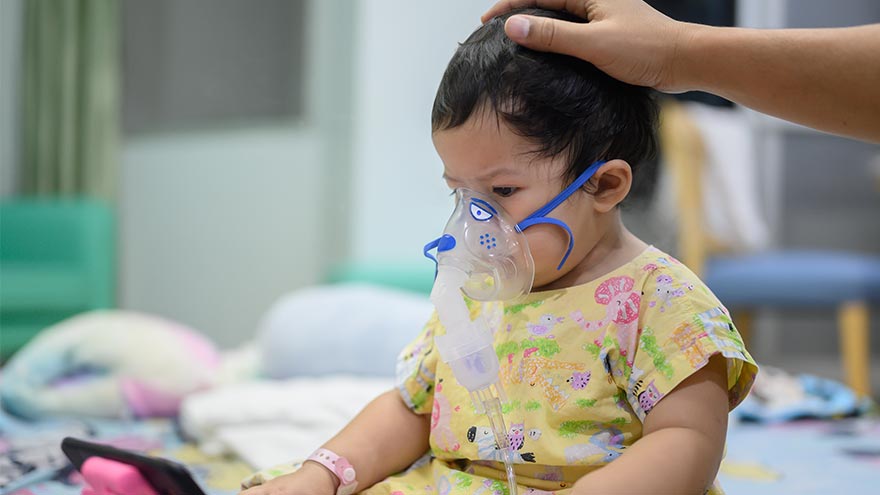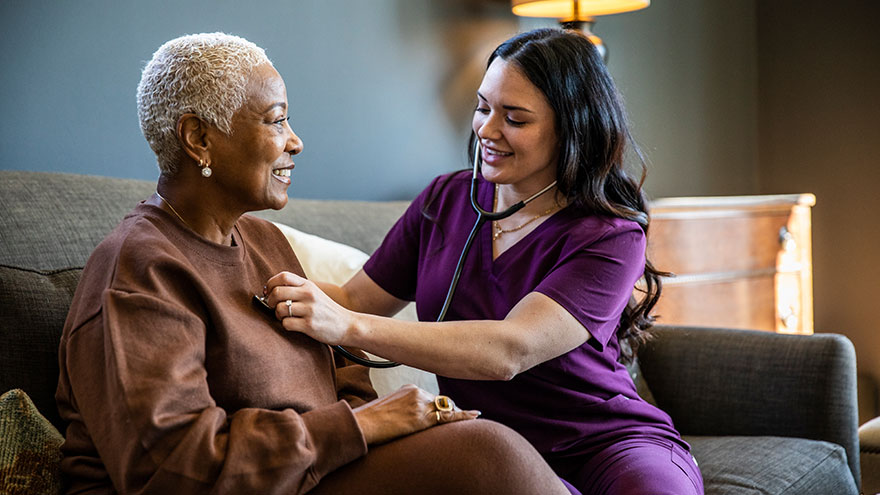Search
-
What Every Parent Needs to Know About SIDS
Although the exact cause of Sudden Infant Death Syndrome is unknown, there are steps parents and caregivers can take to reduce the risk. Here's what every parent needs to know. SIDS is the leading cause of death in the country in infants in their first year of life. However, the exact cause of SIDS still remains a mystery, though it is often attributed to unsafe sleeping practices. Karen Wagner, a Pediatric Nurse Practitioner at Renown Health answers some of the most commonly asked SIDS questions. Protecting Babies from SIDS: Always place babies on their backs when putting them to sleep for naps and at night. Use a firm sleep surface, such as a mattress in a safety-approved crib, covered by a fitted sheet. Share your room – not your bed – with your baby. Your baby should not sleep in an adult bed, on a couch, or on a chair alone, with you, or with anyone else. Keep soft objects, such as pillows and loose bedding, out of your baby's sleep area. Do not smoke during pregnancy or around the baby; these are strong risk factors for SIDS. The risk of SIDS is even greater when a baby shares a bed with a smoker. To reduce risk, do not smoke during pregnancy, and do not smoke or allow smoking around your baby. Your SIDS Questions Answered: Who's most at risk? Three out of five SIDS victims are boys. African American and Native American infants are twice as prone to the syndrome. Other groups at increased risk include preemies, low-birthweight babies, and infants exposed to cigarette smoke. Is putting my baby down on their back really that important? It's vital. Back-sleeping increases a baby's access to fresh air and makes her less likely to get overheated (another factor linked to SIDS). I put my child to sleep on their back at night, but can I let this rule slide for a short nap? It's not worth the risk. Babies who normally sleep on their back are 18 times more likely to die of SIDS when placed down on their tummy for a snooze. Is side-sleeping safe? No. Studies show that putting a baby down on her side rather than on her back doubles the SIDS risk. It's easier for an infant to roll onto her tummy from her side than from her back. I'm worried about my baby getting cold. Is it safe to cover them with a blanket? Wait until their first birthday. Blankets, pillows, comforters and stuffed toys can hinder your child's breathing; even soft or improperly fitting mattresses can be dangerous. If you're worried that your little one may get chilly, swaddle them in a receiving blanket or use a sleep sack.
-
3 Ways to Enroll in a Hometown Health Insurance Plan
Are you looking for health insurance coverage for the upcoming year? In that case, it's time to browse your options for an Individual or Family Plan. The Open Enrollment Period is now until Dec 15, 2022. So, if you're looking for coverage by Jan 1, 2023, you must enroll by Dec 15, 2022. 1. Get a Quote Online Suppose you don't qualify for a health insurance subsidy, no need to worry! You can still choose an individual and family health insurance plan from Hometown Health. Get a quote online by providing your location, the type of coverage you're looking for and your personal/family details. Once you've provided this information, you'll receive health plan options and pricing. And, if you find a plan you like, you can easily self-enroll online. Get Your Online Quote Today 2. Enroll Through the Nevada Health Link Hometown Health offers Individual and Family health insurance plans on Nevada's Healthcare Marketplace, the Nevada Health Link. Through Nevada Health Link, eligible Nevada consumers can shop for, compare and purchase quality and affordable health insurance plans with ease. Nevada Health Link is the only health insurance resource that can provide eligible candidates with federal tax credits and subsidies to help cover the cost of your health insurance. Use Hometown Health's Insurance Subsidy Federal Poverty Level Calculator to see if you qualify for a tax credit or subsidy. Enroll via Nevada Health Link 3. Work with a Health Insurance Broker Hometown Health is northern Nevada's local insurance provider and if you have questions about Individual and Family Plan insurance benefits, you’re in luck! Hometown Health partners with our local health insurance brokers who will work with you, typically at no cost, to help you understand health insurance plans and benefits and find the plan that is best for you. Need assistance finding a broker? Connect with our team by submitting the form below. They'll provide you with a list of our local broker partners. Find a Broker Near You
Read More About 3 Ways to Enroll in a Hometown Health Insurance Plan
-
Lung Cancer Screening and Early Detection
Lung cancer is the leading cause of cancer deaths in both men and women in the U.S. The good news is the five-year survival rate increases dramatically if lung cancer is treated before spreading to other parts of the body. Julie Locken, MD, of Renown Health Imaging, explains more. What are the signs and symptoms of lung cancer? As you might expect, most lung cancer symptoms appear in the chest and can affect your breathing. Watch for signs such as: Persistent cough Constant chest pain Shortness of breath Wheezing Bloody or rust-colored phlegm Hoarseness Swelling of the neck Pain or weakness in the shoulder, arm or hand Recurring pneumonia, bronchitis or other lung infections Loss of appetite and loss of weight can also be signs of lung cancer That said, there are usually no symptoms in the early stages of lung cancer, which means getting screened can truly be a lifesaver. If you have a history of smoking, you should get screened as a precaution. What are the risk factors of lung cancer? Around 80% of lung cancer cases stem from a history of smoking tobacco. But there are other known causes, such as secondhand smoke, radon, asbestos and diesel exhaust. It’s important to do what you can to eliminate exposure to all of these to reduce your lung cancer risk. People with an immediate relative – a parent, sibling or child – diagnosed with lung cancer and people between 50 and 80 years old are also at higher risk and may need to consider screening. People who are at the highest risk are those with a history of smoking tobacco, particularly smokers who averaged one pack of cigarettes per day for 20 years or more, as well as former heavy smokers who quit in the last 15 years.
-
Cranberry-Jalapeño Cream Cheese Dip
The red and green tones of this flavorful Cranberry-Jalapeño Cream Cheese Dip are perfect for the holidays and super simple to make. So, tantalize your guest's tastebuds with this sweet, spicy, tart, and creamy appetizer!
-
10 Facts About Seasonal Affective Disorder
Seasonal Affective Disorder (SAD) is a form of depression linked to seasonal changes. Learn to recognize the symptoms of SAD in your kids (or yourself) should they appear. We checked in with Dr. Vanessa Slots, the Division Chief of General Pediatrics at Renown to help us understand this condition. 1. Blame SAD on the sun—or the lack of it Seasonal Affective Disorder is a more severe form of the “winter blues. Over-sleeping, feeling irritable or unhappy, and withdrawing from people are classic symptoms of SAD. Approximately 90 percent of people with SAD experience depressive symptoms yearly in the fall and winter, while about 10 percent have depression in the spring and summer. The causes of SAD aren’t explicitly known. Still, researchers believe it’s related to a change in circadian rhythms, with differences in the amount of sunlight during different times of the year as one factor. 2. The further north you live, the more common SAD becomes While Seasonal Affective Disorder is predominantly an adult condition, estimates are that one million children in North America have it. Interestingly, SAD does not occur in the tropics. 3. SAD is more recognizable in adults than in children Common symptoms include feeling “empty,” pessimistic, hopeless, short-tempered, restless and not knowing what to do with oneself. Symptoms vary greatly from one individual to the next. SAD is more common in women than in men. When symptoms are severe, physical examinations are required to rule out other medical causes and determine whether antidepressant medication is needed. 4. In teenagers, symptoms tend to revolve around school-related issues Schoolwork suffers, students have difficulty getting up in the morning and arriving late for class, homework is incomplete, and grades may plummet. Afflicted students have difficulty concentrating, remembering details and making decisions. They lose interest in activities that they previously enjoyed. Some teenagers tend to overeat, crave carbohydrates such as pasta and gain weight. Many teachers, school counselors and therapists should be more familiar with Seasonal Affective Disorder.
-
Berrylicious Parfait
Treat yourself and your family to this tasty delight on those busy pre-holiday mornings. Super quick to make, this light berry parfait is naturally sweet, packed with protein and texture, and has less than 300 calories!
-
Alzheimer's Safety Tips for Caregivers to Know
November is National Alzheimer’s Disease Awareness Month. At Renown Health, we know that Alzheimer's safety for your loved one is a priority, as the symptoms can sometimes lead to unsafe situations. We asked Dr. Jonathan Artz – a neurology physician with Renown Health and an assistant professor of clinical neurology at the University of Nevada, Reno School of Medicine – for tips on keeping loved ones safe and secure. According to the Alzheimer’s Association, Alzheimer’s disease affects safety in various ways, specifically due to body and brain adjustments. These changes can include: Judgment, including forgetfulness Sense of place – getting lost on the way home Behavior – being suspicious or fearful Body difficulty – losing balance Sensing ability – noticeable sensitivity in hearing, seeing or temperature Dr. Artz gives us four major tips to ensure your loved one’s safety as you both navigate this disease together. Watch for Wandering Those experiencing Alzheimer’s disease tend to wander and get lost. Try the following tips to reduce the risk of wandering: Get your loved one an ID bracelet and have them wear it at all times. You can also enroll your loved one in “Wandering Support.” Install door chimes so you know when exterior doors are open. Ask neighbors to call you if they see your loved one out alone. Go with your loved one when they insist on leaving the house. Don’t argue or yell. Instead, use distraction or gentle hints to get them to return home. Discourage Driving Driving can be unsafe for someone with this disease. With this in mind, ask a doctor whether it’s safe for your loved one to drive. For example, on a case-by-case basis, there are certain situations where doctors are required to report individuals with particular cognitive impairments, wherein a form of a driving assessment will be recommended. Limit access to the car. Keep the keys with you or lock them away. Ask an authority figure, such as an insurance agent or a doctor, to tell them not to drive. Adult-Proof Your Abode A simple living space is a safe living space. This means reducing clutter and removing any issues that may pose a safety concern. You may also want to get advice from an occupational therapist (home safety expert). Keep in mind that some changes may not be needed right away. Focus on major safety concerns first. Try the following tips: Add lighting (or glow-in-the-dark tape) to brighten dark areas, including stairways and halls. Use color contrast or texture indicators for dials, knobs and appliance controls. Remind your loved one not to carry items while walking to avoid a fall. Remove sharp objects from drawers and countertops. Avoid using small throw rugs or doormats, as they are easy to trip on. Move frequently used items so that they are easy to reach. Lock away alcohol and tobacco products, as they are not recommended for dementia patients. Install handrails in the shower, tub and near the toilet. Bathroom falls are especially common. Adjust the setting on your hot water heater so water does not scald. Those with Alzheimer’s can lose their sensitivity to temperature. Move and lock up hazardous chemicals and cleaning supplies, such as bleach and insecticides. Disable and remove guns or any weapons. Supervise any medication taken by your loved one. Promote a Positive & Healthy Lifestyle Continually emphasize the strengths of your loved one by promoting participation in meaningful activities, wellness visits and healthy habits to help them improve their well-being. Here are some ways to keep them physically and mentally active: Maintain regular vision and hearing screenings and make necessary adaptations. Establish a routine for daily activities. Encourage participation in self-care and leisure activities. Work with your loved one’s doctor to establish a healthy diet. Ensure proper hydration. It may help to set reminders for your loved one to drink fluids. Encourage regular exercise. Exercise delivers oxygen to the brain, improving brain health. Promote good sleep habits. Good quality sleep can increase overall brain health and has been associated with improving memory, attention and concentration. Resources and support are available with the Renown Memory Disorders Program. Providers within this program are specifically dedicated to treating several different memory-related disorders. Memory Disorders Resources & Support.
Read More About Alzheimer's Safety Tips for Caregivers to Know
-
More Than a Cold
Respiratory syncytial virus, also known as RSV, is a common respiratory virus that impacts the lungs and breathing pathways. The virus can be dangerous for infants and young children and is also concerning for older adults. While most older kids and adults only experience cold-like systems and recover in a week or two, an estimated 58,000-80,000 children younger than 5 years old are hospitalized due to RSV each year, and in 2022 healthcare organizations across the country are experiencing higher infection rates than in years past. "RSV typically peaks in the winter, but this season we are seeing an earlier surge in cases,” said Dr. Vanessa Slots, the Division Chief of General Pediatrics at Renown. “Infants who are infected with RSV almost always show symptoms. Call your healthcare provider immediately if your child is having difficulty breathing, is not drinking enough fluids or is experiencing worsening symptoms.” Symptoms of RSV: Runny nose Decrease in appetite/inability to drink Dry diapers, an indication of dehydration Cough, which may progress to wheezing or difficulty breathing Irritability (most common in very young infants) Decreased activity (most common in very young infants) Decreased appetite (most common in very young infants) Apnea, pauses in breathing for more than 10 seconds (most common in very young infants) What to do if you think your child has RSV: Call your pediatrician! If you suspect your child might have RSV, consulting their healthcare provider is the best first line of defense. From here they will help you build an appropriate treatment plan for child. Keep in mind that many pediatrician offices offer 24/7 call lines. If your child is experiencing retracted breathing (when the area between the ribs and in the neck sinks in when a person attempts to inhale), dehydration (not drinking and decrease in wet diapers) or apnea (pauses in breathing for more than 10 seconds) please call 911 or go to the closest emergency room. Treating RSV from home: Clear your child's nasal pathway with a bulb syringe or saline spray/drops Stay home and rest Drink plenty of fluids to prevent dehydration Manage fever with fever reducers such as acetaminophen or ibuprofen Preventing the spread of RSV: Good news! The biggest RSV prevention tips are almost identical to what we’ve already been doing to prevent COVID-19 – so hopefully, these actions are already second nature. If you have young children or regularly encounter younger children, remember to: Wash your hands often Keep your hands off your face Avoid close contact with sick people Cover your coughs and sneezes Clean and disinfect surfaces Stay home when you are sick Get vaccinated against the flu and COVID-19 to prevent more serious co-infections RSV is dangerous for older adults, Too Older adults – especially those over 65 years old, have chronic heart or lung disease or a weakened immune system – also need to be hyper-vigilant about RSV. If you or your loved one is in the older adult at-risk group, remember to follow the above prevention measures and talk to your healthcare provider immediately if you suspect you have RSV. *Data courtesy of the Center for Disease Control and Prevention.
-
Department Spotlight: Customer Engagement Center
Do it for the patient. That’s the motto that each employee in the Customer Engagement Center (CEC) lives by every single day. This team spins all the existing stereotypical thoughts about call centers on their side by empowering and partnering with patients to achieve their best health. Being transferred around several times just isn’t in this team’s DNA – being a one-stop-shop for patient scheduling, referrals, insurance matters and more is how they proudly operate. Through elevating the customer engagement experience, the CEC closes care gaps to ensure patients get the right care at the right time. From employees who work from our home base in Reno, all the way to the southeastern corner of Florida, this primarily remote team stays firmly connected and collaborative to make patient care possible for all Renown Health patients and Hometown Health and Senior Care Plus members. The “Make It Happen” Department Back-to-back phone calls about a wide variety of patient needs? They make it happen. Referrals that need to go directly to the provider? They make it happen. Complex insurance questions that need to be resolved? They make it happen. The CEC is the keeper of all things customer service and all things patient satisfaction, leveraging technology to improve engagement and accessibility – and they wear that badge with pride. “Patient care is our first priority,” said Cindy Arevalo, Supervisor of Customer Engagement. “Even though we aren’t face-to-face with them, we are always there to help them over the phone with whatever their needs are.” The CEC has a lot of different sub-departments under its umbrella: scheduling, referrals, insurance, patient outreach, personal assistants, MyChart customer service and more. Each team handles calls for a different section of our health system, including the hospitals, imaging, primary care and specialty care. While their individual teams may be different, one aspect of their jobs remains the same: they care. Deeply. “We advocate for the patient, especially when they can’t advocate for themselves,” said Amanda Ishii, Referral Specialist. “We are the first people that patients speak to, and we all have empathy to listen to them, help them solve their problems and take as much time as they need to care for their needs,” added Susana Arroyo Garcia, Supervisor of Customer Engagement. Customer loyalty is key to the CEC. Every CEC team member builds strong relationships with patients and members. Whether they manage patient outreach or manage back-to-back inbound calls, each employee feels a special connection to the helpful work they do to solve a variety of patient concerns. “As Senior Care Plus Personal Assistants, for instance, we help guide our members through complex situations, and we eliminate the process of transferring them to different departments, becoming a ‘one-stop-shop' for them,” said Stephanie Perez Campbell, Senior Care Plus (SCP) Health Coordinator. “While every day is different, we are constantly learning new things and helping members navigate through the health system." With the 4.5 million calls the CEC handles per year, the nature of their jobs is undoubtedly fast paced. However, this does not intimidate the CEC team members; instead, it inspires them to continue reaching new milestones, helping thousands of patients and members every year by handling all the scheduling and referral work on the backend so that they can receive the care needed. “I never find myself sitting around asking, ‘what should I do next,’” said Gina Briles, Supervisor of Customer Engagement. “We always support each other to stay on top of it all in order to take care of our patients.” By wearing a lot of hats and managing many different work queues all while staying engaged with each patient, the CEC is full of natural problem-solvers, helping our healthcare network run smoothly. “The Engagement Center is the front door for the community; serving as the voice of the customer, we ensure patients do not fall through the cracks of the complex healthcare system and are able to easily access the right care at the right time through an exceptional experience,” said Candace Dietrich, Director of Customer Engagement. Consistently Connected With thousands of referrals to process and millions of calls to field, the ways the CEC stays connected to patients and members as well as each other can be related closely to magic. No concern goes unnoticed, and no problem is too complicated. “The sheer volume of patients we engage with is incredible,” said Rene Jacinto, Manager of Customer Engagement. “We processed nearly 200,000 referrals and authorizations last year.” “We expect a steady increase of calls year-over-year. My team processed 1,259 referrals in one day alone recently,” added Arielle Gomes, Referral Specialist. A superpower that every CEC team member holds is the ability to listen. According to this department, active listening is key when problem-solving with every patient and member, as that skill helps them anticipate patient needs and resolve their issues quickly and efficiently. “I’ll always listen,” said Alex Gomez, Customer Engagement Representative. “I want them to know that they are in good hands, especially when they are feeling scared or frustrated.” Team members like Alex help carefully guide customers through the Hometown Health and Senior Care Plus enrollment process, increasing membership and engaging patients to find the perfect plan for them. One of the largest challenges the CEC faces is the departures and arrivals of providers. The ebbs and flows of all hospital systems include provider departures and shifting provider availabilities. Despite this challenge, the CEC staff work hard to ensure communication with all patients regarding provider changes is consistent and that all patients are scheduled in a slot that works for both their schedule and the provider’s schedule. “It’s important for us to be flexible, because things can change at a moment’s notice,” said Gina Briles. “This is more than just a job – we are here for our patients. What we are doing impacts everyone.” Throughout all times of transition, the CEC builds robust relationships with both patients and providers within our organization and community, a skill that this team emphasizes as “fundamentally important.” For example, SCP Personal Assistants like Stephanie Perez Campbell will coordinate care with community resources and offices, giving members one less call to make and one less hurdle to cross in order to get the care they need. On top of it all, even though this team has the ability to work from all 50 states (and many of them work outside of Nevada!), every employee feels connected to their colleagues and their work. “This is the best group of people I’ve ever worked with,” said Riley Petro, Manager of Customer Engagement – Imaging. “I am super lucky for this job and am so thankful for these people.” Proud and Powerful The proof is in the pudding – or rather, the proof is in the numbers. Within the 4.5 million calls they successfully field every year, approximately 1.6 million of those calls route through the private branch exchange (PBX) team – the team that oversees the main operator lines – under the guidance of Jess Nater, Supervisor of Customer Engagement. The CEC is also on track to handle nearly 300,000 referrals this year alone. Additionally, the Hometown Health CEC team was recognized nationally this year with a five-star rating from Medicare. “We all have the initiative to grow, and because of this, we are always learning something new,” said Cindy Arevalo. “Our leaders also support our growth, especially if we want to skill-build or advance in our careers.” The CEC is frequently the first stop on the career ladder for many employees as they start their journey in healthcare, and CEC leadership is committed to the growth and development of their teams to reach their career goals at Renown. The secret formula for all this success can be in part attributed to the pride each CEC employee has for their team, their work and Renown. “We have a very supportive team,” said Holly Coffey, Supervisor of Customer Engagement. “I’ve seen our leaders support their teams tremendously.” “We rely on each other,” added Ashleigh Carty, Customer Engagement Representative. "I love the relationships we create with one another.” Employees in the CEC come from many walks of life, choosing to work at Renown and Hometown Health for a variety of different reasons, many related to the positive power our health system holds. Team members in this department hold a myriad of different career backgrounds, including pharmacy technicians, medical assistants, population health professionals, community health workers and more. Some team members, like Nikki Clifford, Customer Engagement Representative Lead, heard wonderful things about Renown from her mother, who also works for Renown. According to Nikki, “seeing how happy my mom has been in her career made me want to join too. I’ve loved it here ever since.” Katie Lunau, Supervisor of Customer Engagement, also grew up in a family involved in healthcare, and she wanted to follow in their footsteps. Choosing Renown as the place to follow her family path was a simple one, because “Renown stood out as the company that was actively involved in the community helping others.” For other team members, like Susana Arroyo Garcia, Ashleigh Carty and Stephanie Perez Campbell, Renown and Hometown Health’s impact on the local healthcare landscape was their primary driver for choosing a career here and in the CEC specifically. “Renown is very well-known in the area,” said Stephanie Perez Campbell. “I went to school in Reno for public health, so Renown came up all the time in my schooling. I knew Renown had a lot of different opportunities available for career growth, and with the friendly environment I always experienced here, it was an easy decision.” “Once I went through the interview process and joined the team, I immediately realized that there are outstanding managers, support systems and communication skills here. People genuinely care,” added Ashleigh Carty. Ashleigh is exactly right. As emphasized by every team member, employees in the CEC care. Their heightened levels of care and empathy set the bar high for all at Renown and Hometown Health, and their impact will be felt for years to come.
Read More About Department Spotlight: Customer Engagement Center
-
Know Before You Go
Grab your skis, goggles, coat – and don’t forget that helmet. Skiing and snowboarding are fun activities for all ages but come with the risk of injury. Read on for tips to make it a safe day on the mountain. Daydreaming about your next trip to the slopes? We talked to Jared Worchel, DO, about his top tips for gearing up. Get the Gear Before you head out to ski or snowboard, make sure you have all your gear ready and in good condition. Everything should fit correctly so that it keeps you as safe as possible. Wearing proper gear will also help keep you warm. Items to check on before you head out include: Boots Bindings Goggles Poles Helmet Outwear Gloves Pack water and snacks in case the drive takes longer than you except due to weather or traffic. You’ll also want to make sure that your cell phone is fully charged before you head out in case you need to contact friends of staff for help while on the mountain. Helmet, Helmet, Helmet Having a helmet that fits correctly is the most important thing you can do to prepare for a safe day on the mountain. According to a National Ski Areas Association study, helmet use has increased over the last 15 years, with 80 percent of skiers and snowboarders using helmets. Schubert would like to see that number increase to 100 percent. “If you have a head injury it could take you out for the rest of your life,” Dr. Worchel said. “The most important things to think about when fitting a helmet are making sure that it really fits you appropriately. You want to go into a store and try on as many different helmets as they have available. I know it’s tempting to buy one online, but you’re never going to know if it fits correctly.” If you are in an accident, your helmet’s fit can help protect you. Dr. Worchel has some tips on fitting: A helmet should fit low and snug over the head. Make sure that the helmet doesn’t wiggle or feel loose. Look for a model that has adjustability in the back, which will help you make sure it fits snugly. F ind a helmet with a chin strap that will help it stay in place throughout the day.
-
Top 5 Misconceptions About Clinical Trials
There are many misconceptions about clinical research, so we have unpacked a few common myths we hear to help you make an informed decision in your healthcare. Misconception #1: If I join a clinical trial, I’ll just be a guinea pig. Quite the opposite is true! Through honest and respectful conversation, we ensure all participants are informed of the benefits and risks associated with the clinical trial during the informed consent process. Being in a clinical trial is voluntary, and we respect our patients’ decision to join or decline to participate in the clinical trial. You can always change your mind at any time as well. When patients join a clinical trial, they receive an additional team of healthcare professionals, including additional physicians, pharmacists and research coordinators, dedicated to their safety and well-being. This means that clinical trial participants often receive more support than they would in the standard treatment setting. Misconception #2: Clinical trials are too dangerous because they use new treatments that haven’t been tested. We recognize that there are different levels of risk associated with participating in a clinical trial depending on the type of study. However, new treatments are only reviewed through clinical trials after they have gone through extensive testing. New treatments that do not show promising results for safety and potential benefit during laboratory testing do not receive approval to begin clinical trials. Your research team reviews any expected benefits and risks identified from previous studies during the informed consent process, as well as any updates that occur throughout the duration of the clinical trial. The research team stays in close contact with you during the entire process, documenting and treating any side effects that you experience for both your safety and the safety of participants like you. Misconception #3: I don't want to join a trial because I could be wasting my time receiving a placebo. A placebo is a substance that has no therapeutic effect, sometimes called a “sugar pill.” Participants who receive a placebo during a clinical trial are very important, helping researchers definitively determine the specific good and bad effects of the new medication. Many clinical trials that involve a placebo also offer what is called an open label extension or cross-over study. Cross-over studies ensure that anyone taking the placebo can begin receiving the new medication, often for several years. Cross-over studies help clinician researchers understand the long-term effects of a medication while also giving patients free access to novel care for several months and even years.
-
5 Things to Know About Women’s Heart Disease
Heart disease is more common in women than many people think. In fact, it is the leading cause of death in the United States, ahead of cancer and stroke. However, the common signs and symptoms we often associate with men and heart disease don’t always align with women. Thankfully, Renown Health is home to the first women’s heart center in Nevada. The Helaine Greenberg Women’s Heart Center gives women in our community the opportunity to receive exemplary care and education. “At the Women’s Heart Center, we are proud to offer the women of our community the treatments, therapies and education they need to fight this silent killer,” Dr. Danish Atwal. 1. The warning signs for heart disease present differently in women than they do in men. Both men and women may experience chest pain during a heart attack, but the similarity of symptoms ends there. Heart disease is especially problematic for women because more than half of women who die of heart disease have no symptoms at all. Women tend to have subtler symptoms that mimic symptoms associated with common, mild illnesses: Fatigue or weakness Pain, pressure or tightness in the center of the chest Pain that spreads to the upper body, neck or jaw Sweating, nausea or vomiting Sudden dizziness Shortness of breath Trouble sleeping 2. Women are often not treated with the same medications as men, even when they should be. Women are less likely to receive heart medication because their disease is often misdiagnosed or because they do not seek proper care. According to a study done by Harvard Health Publishing in 2020, “A general lack of awareness of women’s heart disease may lead to doctors or patients missing heart attacks in women or delaying their diagnosis. For example, while the frequency of cardiovascular disease tends to be lower in women before menopause than in men, the frequency dramatically increases after menopause, when it accounts for approximately one out of every three deaths in women. 3. Women who have hypertension, high cholesterol, type 2 diabetes or gestational diabetes during pregnancy are at a higher risk of a heart attack in the future. Women who experienced complications related to developing high blood pressure or hypertension during pregnancy had a 63% increased risk for developing cardiovascular disease later in life, as stated by research funded by the National Heart, Lung, and Blood Institute. According to that same study, researchers found that early screenings and monitoring in four target areas – blood pressure, cholesterol levels, glucose levels and body mass index – could provide even more personalized targets to help delay or possibly prevent future cardiovascular events among women.
Read More About 5 Things to Know About Women’s Heart Disease











